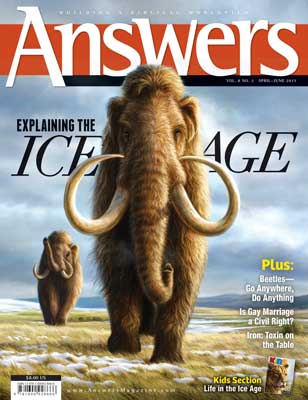One Step Closer to Jurassic Park
Perspective
The survival of DNA within dinosaur bones would be powerful evidence against a millions-of-years age for those fossils. That is one reason a recent discovery has stirred such controversy.
Could dinosaur DNA survive for millions of years? Even its discoverer is loath to admit it, but the clear answer is no.
In 2005 when Dr. Mary Schweitzer and her team first reported finding original soft tissue, including blood vessels, in dinosaur bone, many of her fellow scientists insisted that she must be mistaken. She must have found residues (called biofilm), they said, left by bacteria and not actual dinosaur tissue. Schweitzer persisted and has now identified a number of soft tissues, such as bone-forming cells (called osteocytes), that are made only by creatures with bones. Most recently, Schweitzer and her team discovered in a T. rex and a duck-billed dinosaur four proteins that are found only in bony creatures. More important, the team discovered DNA in the unfossilized osteocytes, and the tests show that the DNA came from a vertebrate, not bacteria.*
Could dinosaur DNA survive for millions of years? Even its discoverer is loath to admit it, but the clear answer is no.
After death, DNA-repair mechanisms cease to function, and the DNA deteriorates. Bacteria and water also destroy DNA. An extensive and exacting study of bones from New Zealand’s extinct giant moa bird calculated that the lifespan of a DNA strand should be measured in thousands, not millions of years.** Even this fast decay rate is slower than rates seen in laboratory tests, which are 400 times faster and could be measured in decades. So, even under the best conditions for preservation—a constant temperature of 23ºF (-5ºC)—the DNA would disintegrate completely in a fraction of the 65 million years that have supposedly passed since the last dinosaur died.
What researchers are seeing clearly does not support their beliefs about earth history over millions of years. The findings do, in contrast, support the view that these dinosaurs lived only 4,300 years ago and were buried during the global Flood.
* M. H. Schweitzer, et al., “Molecular Analyses of Dinosaur Osteocytes Support the Presence of Endogenous Molecules.” Bone, 52 no. 1 (2013): 414–423.
** M. E. Allentoft, et. al., “The Half-life of DNA in Bone: Measuring Decay Kinetics in 158 Dated Fossils,” Proceedings of the Royal Society B. 279 no. 1748 (2012): 4224–4733. The tests looked at a DNA strand.
Answers Magazine
April – June 2013
What unique conditions were required to start the Ice Age, and where does it fit in Bible times? Why did Ice Age animals grow so big, and what happened to them? Also, can you explain why God made more species of beetles than any other animal? Can you prove that Genesis 1–3 is not a Near Eastern myth? Read the answers to these questions and many, many more in this issue!
Browse IssueRecommended Resources

Answers in Genesis is an apologetics ministry, dedicated to helping Christians defend their faith and proclaim the good news of Jesus Christ.
- Customer Service 800.778.3390
- Available Monday–Friday | 9 AM–5 PM ET
- © 2025 Answers in Genesis





